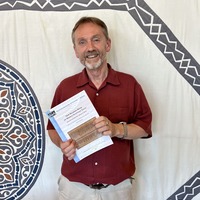- Leiden University Institute for Area Studies
Department of Egyptology
Witte Singel 25
Postbus 9515
2300 RA Leiden
the Netherlands
Olaf Kaper
Universiteit Leiden, Egyptology, Faculty Member
Jüngste Ausgrabungen in den sakralen Bauten von Berenike haben eine Reihe von Statuen ans Licht gebracht, die den Ort mit dem Königreich von Meroe in Verbindung bringen. Vier Statuen werden besprochen, insbesondere eine komplexe... more
Jüngste Ausgrabungen in den sakralen Bauten von Berenike haben eine Reihe von Statuen ans Licht gebracht, die den Ort mit dem Königreich von Meroe in Verbindung bringen. Vier Statuen werden besprochen, insbesondere eine komplexe lebensgroße Statue des Sebiumeker. Sie erscheint in einer hybriden Form, die sie nahe an die Ikonographie des Osiris bringt. Eine Bronzestatuette des Arensnuphis wird nur mit Vorbehalt identifiziert, aber eine Würfelstatue weist eindeutige Parallelen in Naga auf. Ein Kopf des Amun hat eine Parallele in Meroe, was aber nicht unbedingt auf einen meroitischen Ursprung des Stücks hinweist. Die Funde deuten auf die Anwesenheit meroitischer Händler in Berenike als Beteiligte am Fernhandel hin.
Research Interests:
Research Interests: Archaeology, Egyptian Archaeology, Graeco-Roman Egypt, Late Roman Empire, Late Roman Archaeology, and 14 moreAncient Near East (Archaeology), Roman Egypt, Ancient Egyptian Iconography, Ancient Egyptian Art and Archaeology, Ancient Egypt, Tardoantigüedad, Archeozoology, Ancient Greece and Rome, Barbarians and Romans in Late Antiquity and Early Middle Ages, Late Roman and early Byzantine Egypt, American Archaeology, Greek and Roman Egypt, Egipto romano, and Greek and Roman Archaeology in Egypt
Research Interests:
Research Interests:
Research Interests:
Article in Dutch about the god Amon-nakht, a local deity of the oasis Dakhla, whose temple from the Ptolemaic and Roman period was found at Ain Birbiya. The god's name and iconography and discussed and his relation to Amun and Seth is... more
Article in Dutch about the god Amon-nakht, a local deity of the oasis Dakhla, whose temple from the Ptolemaic and Roman period was found at Ain Birbiya. The god's name and iconography and discussed and his relation to Amun and Seth is analysed.
Research Interests:
Article in Dutch about the forms and usage of artificial lighting in ancient Egypt. After discussing lighting of the home, the tomb and the temple, two newly found depictions from Kellis are discussed. In these, a tree of lamps is shown... more
Article in Dutch about the forms and usage of artificial lighting in ancient Egypt. After discussing lighting of the home, the tomb and the temple, two newly found depictions from Kellis are discussed. In these, a tree of lamps is shown as is known from texts, but no actual examples have been preserved. A reconstruction of such a device, used in lighting temples, has been made in 2008 at the Museum of Antiquities in Leiden.
Research Interests:
Article in Dutch on rhythm and recitation in ancient Egypt. The use of music in cultic acts is commented upon, in singing and performing. In this context the hnw-pose is interpreted as reflecting a specific recitation technique that was... more
Article in Dutch on rhythm and recitation in ancient Egypt. The use of music in cultic acts is commented upon, in singing and performing. In this context the hnw-pose is interpreted as reflecting a specific recitation technique that was practiced by priests. Also, animals sounds were imitated by priests in the temples. And finally, a clicking sound is discussed that was made with the hands in Ancient Egypt and that is still practiced in some countries today. This is the sound produced by the goddess Meret.
Research Interests:
Research Interests:
Research Interests:
... gods into heaven, contains a unique epithet for Geb: Gb m snt, perhaps meaning 'Geb as ... The latter texts show that the geographical symbolism attached to Osiris' body could refer to a ... For these... more
... gods into heaven, contains a unique epithet for Geb: Gb m snt, perhaps meaning 'Geb as ... The latter texts show that the geographical symbolism attached to Osiris' body could refer to a ... For these demons, see V. Rondot, 'Une monographie Bubastite', BIFAO 89 (1989), 264-7 and ...
Research Interests:
... Tutu as part of a composite divine name 184 8.1.7. Tutu's name with a divine epithet 185 8.1 ... few 1 JF Borghouts kindly pointed out to me a possible early version of the divine name in ... Spoken Arabic of Egypt, of Greek... more
... Tutu as part of a composite divine name 184 8.1.7. Tutu's name with a divine epithet 185 8.1 ... few 1 JF Borghouts kindly pointed out to me a possible early version of the divine name in ... Spoken Arabic of Egypt, of Greek or Coptic Origin, reprint Cairo 1989, 18, the etymology of this ...
